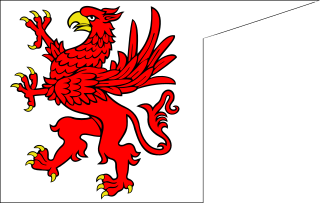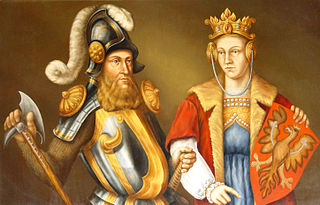History
After the death in 1325 of Wizlaw III, Prince of Rügen, the last Prince of Rügen, Wizla's nephew, Duke Wartislaw IV, was enfeoffed with the Principality of Rügen by the Danish king, in accordance with the contract of inheritance of 1321. Wartislaw, however, died in 1326 and left three underage sons. Then Duke Henry II of Mecklenburg occupied the Rügen territories of Barth, Grimmen and Loitz, claiming he was the legal heir. This led to the First Rügen War of Succession. The war ended with the Peace of Brudersdorf of 27 June 1328, in which Mecklenburg renounced its claims on Rügen, but retained Barth, Grimsby and Tribsees as security. When the sons of Wartislav IV found themselves unable to pay off the pledged land after 12 years, the Second Rügen War of Succession began, which ended in 1354 with the Peace of Stralsund, in which Barth was awarded to Pomerania-Wolgast.
After the death of son Wartislaw IV's son Barnim IV, Duke of Pomerania in 1365, Pomerania-Barth was divided in 1372 under the Treaty of Anklam. The Eastern part, between the rivers Swine and Łeba, was called Pomerania-Stolp and was initially ruled by Duke Bogislaw V and the Western duchies of Pomerania-Barth, initially ruled by Duke Wartislaw VI and Pomerania-Wolgast, ruled by Duke Bogislaw VI. From 1368/72 until 1451 the island of Rügen was also ruled by the dukes of Pomerania-Barth, albeit temporarily as a secundogeniture.
In 1396, Bogislaw VI died and Wartislaw VI inherited his part of Pomerania. He moved his residence to Wolgast, and therefore his part of Pomerania was known as Pomerania-Wolgast. After his death, his sons ruled Pomerania-Wolgast jointly.
In 1415, Pomerania-Wolgast was again split, with Pomerania-Barth being given to Duke Barnim VIII, who also inherited Rügen from his childless brother Swantibor IV in 1440. In 1451, Barnim VIII himself also died childless, and Pomerania-Barth was once again reunited with Pomerania-Wolgast, under Wartislaw IX.
Wartislaw IX died in 1457 and Pomerania-Wolgast was once again divided. Wartislaw X ruled Pomerania-Barth until 1478. This was the last time Barth served as the capital for a fragment of the Duchy of Pomerania, although later Dukes occasionally visited the city.
From 1569 to 1605 it was the residence of Duke Bogislaw XIII, who was not a ruling duke. I the division treaty of Jasenitz, he had been awarded the district of Barth and the secularized monastery of Neuenkamp. When he became a ruling Duke in Stettin in 1603, he initially kept these possessions, but in 1605, he gave them to his cousin Philip Julius, who he renamed Neuenkamp to Francis Castle, in honor of his father-in-law Duke Francis of Brunswick-Lüneburg. After Philip Julius's death in 1625, Barth Castle served as Wittum for his widow, Agnes of Brandenburg, until she remarried with Francis Charles of Saxe-Lauenburg in 1628.
In 1638, during the Thirty Years' War, Barth Castle and all other ducal possessions were impounded by the Swedish crown, who handed them to the military and the civil service. Barth Castle was given to Field Marshal Lennart Torstensson.

The Duchy of Pomerania was a duchy in Pomerania on the southern coast of the Baltic Sea, ruled by dukes of the House of Pomerania (Griffins). The country had existed in the Middle Ages, in years 1121–1160, 1264–1295, 1478–1531 and 1625–1637.
The House of Griffin or Griffin dynasty was a dynasty ruling the Duchy of Pomerania from the 12th century until 1637. The name "Griffins" was used by the dynasty after the 15th century and had been taken from the ducal coat of arms. Duke Wartislaw I was the first historical ruler of the Duchy of Pomerania and the founder of the Griffin dynasty. The most prominent Griffin was Eric of Pomerania, who became king of the Kalmar Union in 1397, thus ruling Denmark, Sweden and Norway. The last Griffin duke of Pomerania was Bogislaw XIV, who died during the Thirty Years' War, which led to the division of Pomerania between Brandenburg-Prussia and Sweden. Duchess Anna von Croy, daughter of Duke Bogislaw XIII and the last Griffin, died in 1660.

Bogislaw V, sometimes known as the Great, was a Duke of Pomerania.
Casimir II was the duke of Pomerania-Demmin from 1187 until his death. He was succeeded by Wartislaw III, Casimir's son with princess Ingardis of Denmark.

Eric II or Erich II was a member of the House of Pomerania and was the ruling Duke of Pomerania-Wolgast from 1457 to 1474. He was the son of Wartislaw IX of Pomerania-Wolgast and Sophia, daughter of Eric IV of Saxe-Lauenburg.

The Principality of Rügen was a Danish principality, formerly a duchy, consisting of the island of Rügen and the adjacent mainland from 1168 until 1325. It was governed by a local dynasty of princes of the Wizlawiden dynasty. For at least part of this period, Rügen was subject to the Holy Roman Empire.
The County of Gützkow was a county in the Duchy of Pomerania in the High Middle Ages. It was established in 1129 from the Castellany of Gützkow. Following the death of its last count in 1359, it was reestablished into the Vogtei Gützkow.

Pomerania during the Late Middle Ages covers the history of Pomerania in the 14th and 15th centuries.

The Duchy of Pomerania-Wolgast, also known as the Duchy of Wolgast, and the Duchy of Wołogoszcz, was a feudal duchy in Western Pomerania within the Holy Roman Empire. Its capital was Wolgast. It was ruled by the Griffin dynasty. It existed in the Late Middle Ages era from 1295 to 1478.

The Duchy of Pomerania-Stolp, also known as the Duchy of Stolp, and the Duchy of Słupsk, was a feudal duchy in Farther Pomerania within the Holy Roman Empire. Its capital was Słupsk. It was ruled by the Griffin dynasty. It existed in the High Middle Ages era from 1368 to 1478.

John Frederick was Duke of Pomerania from 1560 to 1600, and Bishop of Cammin (Kamień) from 1556 to 1574. Elected bishop in 1556 and heir of the duchy in 1560, he remained under tutelage of his great-uncle Barnim XI until he took on his offices in 1567.

Ernst Ludwig was duke of Pomerania from 1560 to 1592. From 1569 to 1592, he was duke in the Teilherzogtum Pomerania-Wolgast, sharing the rule over the Duchy of Pomerania with his older brother Johann Friedrich, duke in the other Teilherzogtum Pomerania-Stettin and bishop of Cammin.

Philipp Julius was duke of Pomerania in the Teilherzogtum Pomerania-Wolgast from 1592 to 1625.
Wartislaw VI of Pomerania was a member of the House of Griffins. From 1365 to 1377, he ruled Pomerania-Wolgast jointly with his brother Bogislaw VI. From 1377 until his death, he was the sole ruler of Pomerania-Barth.
Wartislaw V. was a duke of Pomerania from the House of Griffins. He initially ruled Pomerania-Wolgast jointly with his elder brothers Barnim IV and Bogislaw V. He stood in their shadow and after 1368, he ruled his own part of the Duchy: the Land of Neustettin. Neustettin is now called Szczecinek.
Sophie of Pomerania (1498–1568), daughter of Bogislaw X, Duke of Pomerania; wife of Frederick I of Denmark.

Barnim VIII, Duke of Pomerania was Duke of Pomerania–Wolgast–Barth.
The Wars of the Rügen Succession were two early 14th century conflicts fought primarily between Mecklenburg and Pomerania for control of the Danish Principality of Rügen on the southern Baltic Sea coast.
The Duchy of Pomerania-Neustettin, also known as the Duchy of Neustettin, and the Duchy of Szczecinek, was a feudal duchy of the Holy Roman Empire located in Middle Pomerania. It existed between 1372 and 1478. Its capital was Szczecinek. It was formed from the part of the terretories Pomerania-Wolgast on 8 June 1368 and existed until 1390 when it was incorporated back into Pomerania-Wolgast. Its only ruler was Duke Wartislaw V of the House of Griffins.













